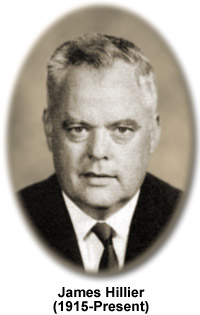James Hillier
(1915-Present)

Although a German scientist is typically credited with developing the concept of electron microscopy and for constructing the earliest electron microscope, two Canadians were the first to make the instrument practical for laboratory use. One member of this pair was James Hillier, who was born in Brantford, Ontario on August 22, 1915. Hillier, who was the son of a mechanical engineer, had childhood aspirations of becoming a commercial artist, but his abilities took him in another direction. The recipient of a science scholarship, Hillier undertook his collegiate education at the University of Toronto, where he studied mathematics and physics. He was awarded a Bachelor of Arts degree in 1937 and decided to remain at the university to pursue graduate studies, eventually receiving a Masters degree (1938) and a PhD in physics (1941).
It was during his graduate years at the University of Toronto that Hillier became involved in a project that would alter the course of his life, as well as electron microscopy in the Western world. In 1937, the director of the school’s physics department, E. F. Burton, asked Hillier and another graduate student, Albert Prebus, to work on the development of a high-voltage electron microscope that could be used to examine biological specimens. Burton had seen the Ernst Ruska model in Berlin two years before, but realized that it was of yet little use in the laboratory. He hoped, therefore, that his students would be able to materialize the potential of the electron microscope, since the instrument could theoretically produce much higher magnifications and than traditional optical microscopes because it focuses a beam of electrons, which have wavelengths much smaller than a beam of light.
Within four months, Hillier and Prebus achieved the task given to them by Burton. The device they created could magnify objects up to 7,000 times their actual size, a significant improvement over 1930s light microscopes, which could only increase the dimensions of specimens by about 2000 times. They spent another year, however, refining the instrument. Then, his coursework complete, Hillier accepted a position with the Radio Corporation of America (RCA) in New Jersey, where he utilized his recently acquired knowledge to help produce the company’s first commercial electron microscope. He remained with the corporation for the rest of his career, retiring as Executive Vice President and Chief Scientist in 1977.
Hillier, who holds 40 patents, has been an active member of various scientific societies and a recipient of a wide array of honors. He was president of both the Electron Microscope Society of America and the United States National Society of Engineers. A 1980 inductee in the United States National Inventors Hall of Fame, Hillier also received the Albert Lasker Award in Medical Research, the Institute of Electrical and Electronics Engineers (IEEE) David Sarnoff Award, and the Order of Canada, a prestigious honor for lifetime achievement.
